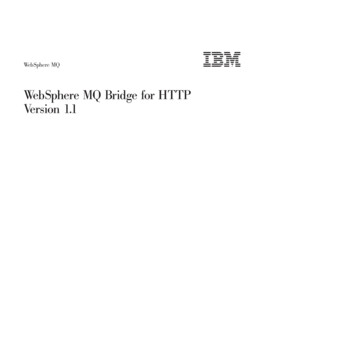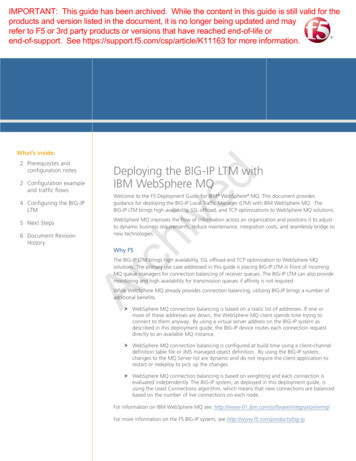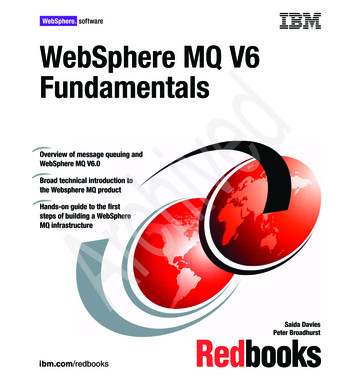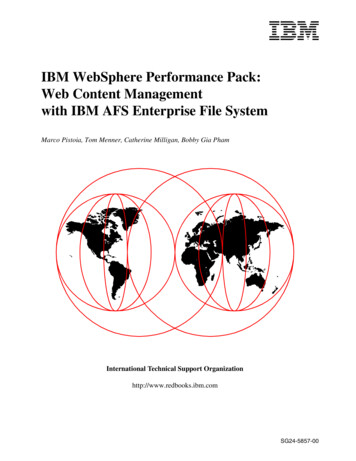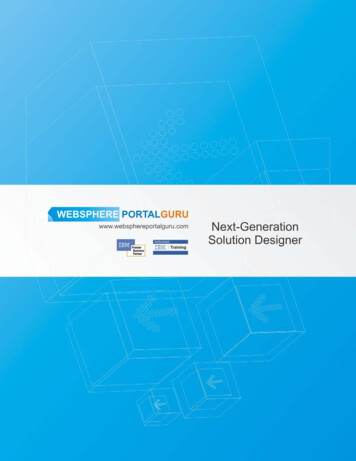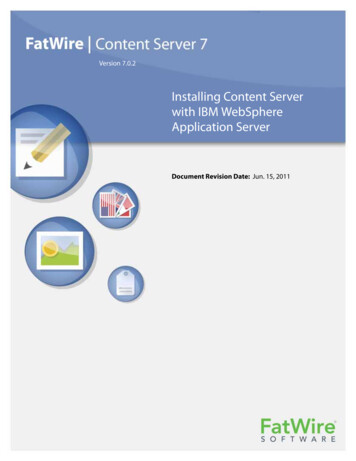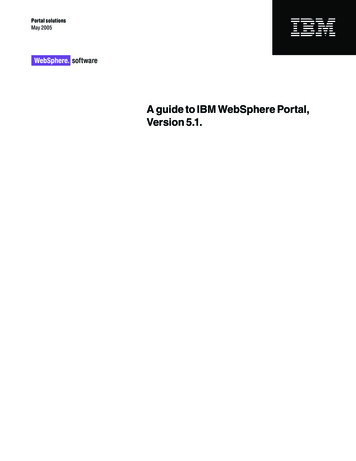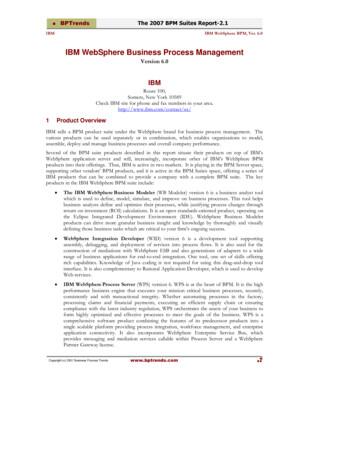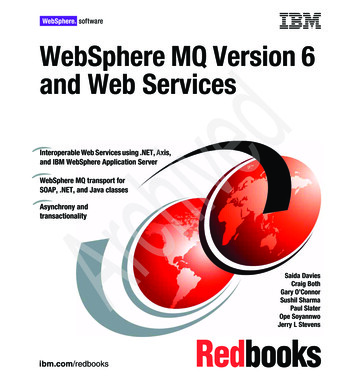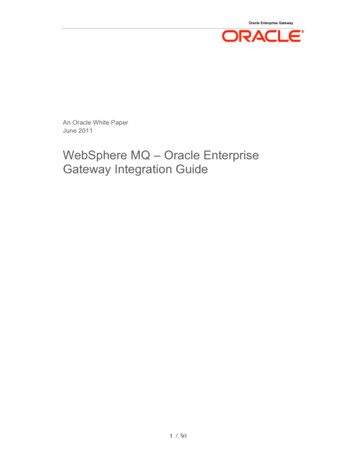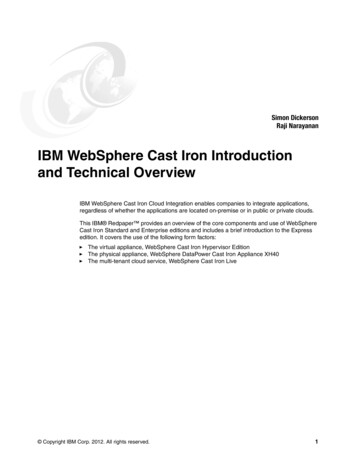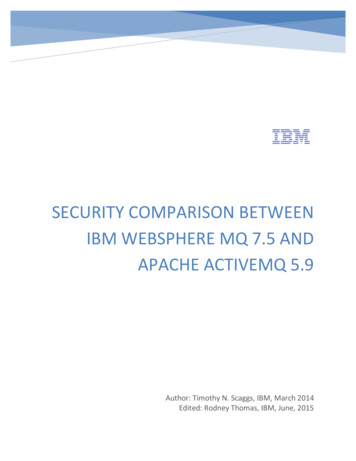
Transcription
SECURITY COMPARISON BETWEENIBM WEBSPHERE MQ 7.5 ANDAPACHE ACTIVEMQ 5.9Author: Timothy N. Scaggs, IBM, March 2014Edited: Rodney Thomas, IBM, June, 2015
Table of ContentsExecutive Summary . 2IBM WebSphere MQ . 2IBM WebSphere MQ Advanced Message Security (AMS) . 2Apache ActiveMQ. 2Role-based Security . 3Illustration of Authentication and Authorization. 3Authentication Procedure . 4Authorization Procedure . 4Product Support of Authentication . 4Product Support of Authorization . 4Auditing . 5WebSphere MQ Auditing support. 5ActiveMQ Auditing support . 5Summary of both Products Auditing support . 5Data Security . 6WebSphere MQ AMS vs. ActiveMQ SSL . 6ActiveMQ and Message Encryption . 8Standards and Compliance. 8FIPS 140-2 . 8Common Criteria . 9NIST 800-131A . 10PCI-DSS . 12Assistance to Cyber Attack Prevention . 12Messaging Proxy support . 13Messaging IP Address Blocking Support . 14Appendix A: SSL Vulnerabilities do not affect Message Encryption . 14Page 1 of 15
Executive SummaryThe IBM Competitive Project Office (CPO) completed an investigation of the relative merits of the securityprovided by IBM WebSphere MQ 7.5 (WMQ) and Apache ActiveMQ 5.9. Areas of investigation included Rolebased Security, Auditing, Data Security, Standards and Compliance, and Cyber-attack Prevention. The studyfocused on three software components:IBM WebSphere MQ IBM’s premiere messaging product (in 2014 IBM shipped version 8.0 and renamed it into IBM MQ). WebSphere MQ provides connection security through SSL and TLS support1.IBM WebSphere MQ Advanced Message Security (AMS) Provides end-to-end message encryption including data in server memory and on disk. Sold under a separate license than WebSphere MQ, but included in the installation.Apache ActiveMQ An Open Source messaging product that provides connection security through SSL and TLS. Data in server memory and on disk is not protected.We found that IBM WebSphere MQ is functionally superior in the area of security to that of Apache ActiveMQ.WebSphere MQ is built from the ground up with security as one of its primary goals, and it demonstrates alead in the area of Data Security as well as Standards and Compliances over ActiveMQ. Please see the chartbelow for a complete overview of the comparison between the two tingWMQActiveMQStrong authentication policies availableYesYesStrong authorization policies availableYesLimitedLimitedLimitedYesNoFederal Information Processing Standards (FIPS) FIPS 140-2YesNoCommon Criteria certification at Evaluation Assurance Level 2YesNoNational Institute of Standards and Technology NIST 800-131AYesLimitedYes *Limited *YesNoYesNoAudit of administrative actions and configuration changesData Security End-to-End Message Encryption (including data at rest on the server)StandardsCompliancePayment Card Industry Data Security Standard (PCI-DSS)Cyber-attack DMZ Proxy SupportPreventionIP address blocking1For more in-depth discussion of WebSphere MQ security, see this free IBM redbook: “Secure MessagingScenarios with WebSphere MQ” lPage 2 of 15
Note: * PCI is a far reaching set of guidelines, many of which WebSphere MQ supports. While there is no formal compliance certification,our research suggests IBM offers good documentation in support of the standard, while ActiveMQ does not. Therefore, ActiveMQ customersmust find other means of support.Role-based SecurityRole-based Security is the verification of the identity of all users, as well as the prevention of unauthorizedaccess of system objects by users that have not been granted privileged access to those objects.Figure 1: Illustration of Role-based securityAnother way of stating this is that Role-based Security is the combination of authentication and authorization.Authentication is the process of verifying a user’s identity, in other words confirming who you are.Authorization is the process of granting and verifying a user’s privileges to objects based on the user’s identity;in other words, determining what actions you can perform within the system.A role is a membership within a group that has a common set of privileges. For instance, if Alice is a member ofthe “Accounting” group, she will have privileges to access the Accounts Payable and Accounts Receivablequeues, if the system is so configured.Illustration of Authentication and AuthorizationBelow is an illustration of both an authentication procedure and an authorization procedure. This illustrationshows how a user named Alice would log into the system and have her identity authenticated. It also showshow Alice would attempt to access an object, and how the system would verify that Alice has been granted theappropriate policy for her to perform the action she had requested. Below the illustration is a step-by-stepexplanation of the steps taking place.Figure 2: Illustration of Authentication and AuthorizationPage 3 of 15
Authentication Procedure1. Alice logs on to the server with a user name and password.2. The server compares Alice’s credentials to ensure they match an entry within its Access Control List(ACL), verifying Alice’s identity.3. The server notifies Alice of her successful authentication.Authorization ProcedureUpon successful authentication, the following steps are repeated for each object Alice wishes to perform anaction upon:1. Alice attempts to perform an action on an object using her verified identity.2. The server examines all authorization policies specifying objects on which Alice retains privileges.3. If Alice’s authorization policies do not allow an action to the requested object, access will be denied.4. Otherwise the server performs the requested action on the requested object.5. The server notifies the client of Alice’s successful action on the requested object.Product Support of AuthenticationBoth WebSphere MQ and ActiveMQ provide authentication support. WebSphere MQ version 8 now providesuser ID and password verification. Similarly ActiveMQ provides user ID and password verification to theircustomers. Users of WebSphere MQ below version 8 with authentication requirements are advised to use SSLclient authentication to provide user authentication. Both of these methods provide a form of authenticationthat meets client needs within the defense, finance, and banking industries.Product Support of AuthorizationBoth WebSphere MQ and ActiveMQ have support for authorization. However, based on the informationprovided below, WebSphere MQ provides a more finely grained set of authorizations. Authorizations withinWebSphere MQ are performed by the ‘setmqaut’ command, allowing up to twenty-five (25) differentoperations to be supported by this command. In fact, there are four main categories of operations within the‘setmqaut’ command:MQI: Authorizations to issue specific MQI callsContext: Authorizations to manage message identity or origin informationAdmin: Authorization for specific administration tasksGeneral: Generic authorizations Authorizations within ActiveMQ are performed by editing an XML file. Only three (3) authorizationsoperations are supported, in contrast to WebSphere MQ’s twenty-five authorization operations. The listsbelow show an overview of the authorization commands allowed by each software product. WebSphere MQ: Provides authorization in the following categories: MQI:put, get, browse, inquire, set, all users, publish, subscribe, connect, resume Context:pass all, pass id, set id, set all Admin:change, clear, create, delete, display, control, reset or resolve General:all, all adm, all mqi, noneActiveMQ: Provides the following authorizations Single Category:read, write, adminIn summary, while both products contain authentication support, WebSphere MQ provides a more finelygrained set of authorization operations.Page 4 of 15
AuditingAuditing is the recording of all user interactions with the software product, allowing an auditor to review allpast historical actions taken to ensure compliance with software practices and directives. For example, if a usercreates a queue named “INVENTORY,” that action should be logged to the audit log.WebSphere MQ Auditing supportWebSphere MQ retains their audit logging within six different queues within the Queue Manager: The tablebelow describes those LOGGER.EVENTDescriptionQueue Manager Event QueueChannel Event QueuePerformance Event QueueConfiguration Event QueueCommand Event QueueLogger Event QueueIBM offers several SupportPacs to monitor audit queues, including: MO01: Event and Dead Letter Queue Monitor MH05: WebSphere MQ -- Events Display Tool MS0K: WebSphere MQ -- Events Monitor Tool MS0P: WebSphere MQ -- Explorer Configuration and Display Extension Plug-ins MS12: WebSphere MQ for z/OS – Print Event MessagesAuthorizations are not logged within WebSphere MQ. WebSphere MQ uses the ‘setmqaut’ command toperform authorizations. While this is an extremely robust command and features a rich set of finely grainedoperations, the results of this command are not sent to any of the auditing queues.These queues can be monitored by Audit monitors, such as the IBM Tivoli Composite Application Manager forApplications (ITCAM), as well as other third-party software packages. Customers can also develop their owncustom applications to monitor the event queues to meet their organization’s specific requirements.ActiveMQ Auditing supportActiveMQ does not place their audit repository on queues. Instead, they place their product’s audit repositoryon a physical file on the disk at the following location: {ACTIVEMQ HOME}/data/audit.logWhere {ACTIVEMQ HOME} is the location that ActiveMQ was installed.Authorizations are not logged within ActiveMQ. Authorizations are performed within an XML file within theActiveMQ architecture. When the physical XML file is edited to change the authorization permitted, ActiveMQhas no method of recording those changes to its audit log.Monitoring of ActiveMQ is provided by third-party Audit monitoring tools, such as Amon and the ApacheActiveMQBrowser.Summary of both Products Auditing supportBoth products provide auditing support, with certain restrictions. Neither WebSphere MQ nor ActiveMQprovide auditing support for authorizations. Most administrative tasks in ActiveMQ require the user to editPage 5 of 15
configuration files directly and thus no auditing can be provided. In contrast, WebSphere MQ has robustadministrative tools (visual, command line and API) and most of the administrative actions can be audited.Data SecurityData security is a requirement of all modern information systems to facilitate the prevention of identity theftand unauthorized access to sensitive data. The protection of information such as Social Security Numbers(SSN), credit card numbers, and health care data is increasingly critical to technology customers.Data security involves the protection of such sensitive information from both internal and external threats.Internal threats could potentially arise from unauthorized access from users within the organization. Forexample, system administrators usually have administrator access to queues to perform operations such as thecreation and deletion of queues. However, system administrators should not necessarily have access to readmessages within a queue, because those messages could contain sensitive data such as credit card numbers.External threats include the protection of sensitive data from outside the organization. External threats wouldinclude the interception of sensitive data flowing across the Internet. For example, if a bank customer accesseshis bank account from a browser, and the transmission between the browser and the bank server isintercepted, then sensitive data could be stolen.A partial solution to the problem of data security occurred when the industry standardized on the SecureSocket Layer (SSL) protocol, and its successor, the Transport Layer Security (TLS) protocol. Both WebSphereMQ and ActiveMQ fully provide SSL and TLS support. SSL and TLS provide security between client and server,allowing data to be transmitted between client and server using a secure cryptology mechanism. However, onsome messaging systems, once the data is received by the server, it is then placed on the server queue in plaintext.A more comprehensive approach is to use message encryption. Message encryption is the term used todescribe the process where the message is encrypted directly from the sending client, but is not decrypteduntil after the receiving client has received the message. Therefore, there is no SSL handshaking involvedwithin message encryption, and no decryption or encryption occurring on the server. This means that themessage never exists on the server in plain text, but only in an encrypted format, and thus the content ofthe messages cannot be viewed by system administrators (this is often called protection of data at rest).Both WebSphere MQ and ActiveMQ provide full support for SSL and TLS. WebSphere MQ supports messageencryption through WebSphere MQ Advanced Message Security (AMS). ActiveMQ does not provide supportfor message encryption (does not protect data at rest).WebSphere MQ AMS vs. ActiveMQ SSLWhile this is not meant to be an exhaustive explanation of cryptology architecture, the following is a high-leveloverview of keys, certificates, and keystores. Keys are used to encrypt and decrypt information. Certificatesencapsulate one or more keys. Additionally, keystores contain public key certificates or private keys, but forthe remainder of this discussion, we will broadly view keystores as a repository of keys.WebSphere MQ AMS is a component of WebSphere MQ that is sold under a separate license, but is included inthe base WebSphere MQ installation package. WebSphere MQ AMS includes certificate-based encryptionutilities provided out-of-the-box for the management of digital certificates. Therefore, WebSphere MQ AMSprovides end-to-end message encryption that is not based on SSL or TLS. Instead, it is a public / private keysystem from keys contained in a client keystore, but not the server’s keystore. Therefore, WebSphere MQ AMSis immune to SSL vulnerabilities such as the HeartBleed vulnerability.Page 6 of 15
In ActiveMQ the client side of SSL will encrypt the message on the sender, then decrypt the message on theserver itself. The message is then placed in plain text on the server. Unfortunately, this allows systemadministrators to potentially view the message, which could contain sensitive information. When the receiverrequests the message from the server, the server will then encrypt the message, send the message to thereceiver, and the receiver then decrypts the message.WebSphere MQ AMS encrypts the message on the sending application and decrypts the message on thereceiving application with no encryption or decryption required on the server itself. Therefore, there is no SSLhandshaking required. The following is an illustration of how this occurs:Figure 3: Differences between WebSphere MQ AMS and ActiveMQ SSL encryptionSince WebSphere MQ AMS only performs cryptology on the sending and receiving applications, keystores areonly contained on the sender and receiver, not the server itself. This prevents a system administrator fromviewing messages on a queue with sensitive information.Figure 4: How WebSphere MQ AMS and ActiveMQ utilize key storesPage 7 of 15
In ActiveMQ SSL, the sender, receiver, and the server must all contain keystores to enable SSL handshaking.This potentially allows an ActiveMQ system administrator to view sensitive data within the queue. However,WebSphere MQ AMS only requires a keystore to be contained on the sender and the receiver. Thisarchitecture prevents system administrators from viewing sensitive data on the server, and it facilitatesgreater configuration simplicity.To summarize: WebSphere MQ AMS is not vulnerable to SSL handshaking vulnerabilities. WebSphere MQ AMS stores messages on server in encrypted format, not viewable by administrators. WebSphere MQ AMS allows a simpler certificate configuration, as no keystores are contained on theserver.ActiveMQ and Message EncryptionActiveMQ does not have any support for message encryption (protecting data in memory and on disk of theserver) out-of-the-box. ActiveMQ customers could hard-code their clients to encrypt a message prior tosending and to decrypt a message after receiving. Customers would also have to manually configure their owncertificate and encryption management. This solution would necess
Most administrative tasks in ActiveMQ require the user to edit . Page 6 of 15 . In contrast, WebSphere MQ has robust administrative tools (visual, command line and API) and most of
